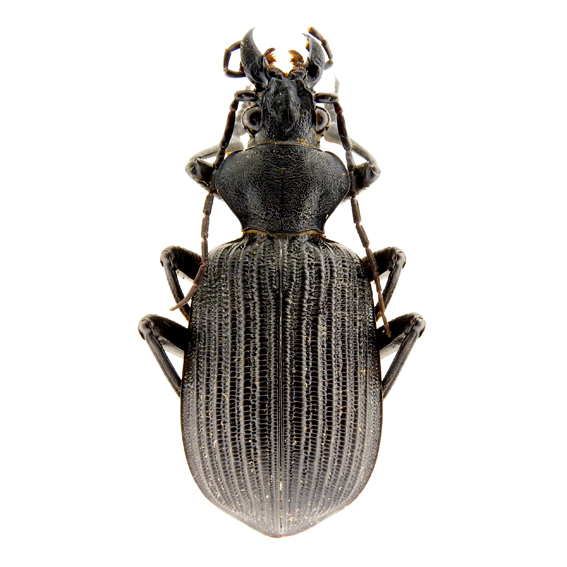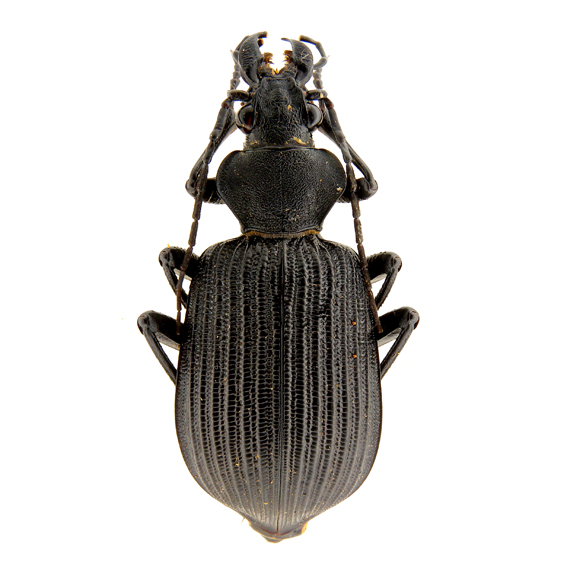Calosoma (Ctenosta) planicolle Chaudoir, 1869
Calosoma planicolle Chaudoir, 1869: 369 (description compatible with one specimen only, from: Zambéze); holotype ♀ designated by Deuve (1978: 250) by monotipy in Muséum National d'Histoire Naturelle, Paris [examined]
Calosoma procerum Harold, 1881: 260 (described from: “Taita und Ukamba”, as taken from the title of the publication) original material and depository not stated
Calosoma (Ctenosta) planicolle Breuning, 1927: 188
Ctenosta planicolle Jeannel, 1940: 130
Length 30-40 mm. The sculpture of the elytra in this species, as it happens in C. senegalense, is characterized by the tertiary intervals that are more elevated than the others (heterodynamic sculpture) and deeply incised. The primary and secondary ones instead consist of rough grains.
However, despite a superficial likeness with C. senegalense, C. planicolle can be recognized because of the glossy black color of the upper body with foveae of the primaries of the same color, the larger dimensions and, any way, examinig the metatrochanters that have a rounded tip in both sexes.
C. planicolle can be found in most sub-Saharan African countries from Niger to the horn of Africa, including Madagascar.
Examined specimens and literature’s data
Angola. Benguela (NMP); Galinda (RMCA); Huila: Quipungo (www.entomologiitaliani.net ), Lubango (www.inaturalist.org/); Luanda (Serrano & al., 2017: 205); Malanje: Cacuso (www.inaturalist.org/)
Botswana. Ngamiland district, NE of Maun, Tamalakane lodge, Borolong Ward (www.inaturalist.org); Serowe, Gaborone, Tutume, Francistown (www.inaturalist.org/).
Republic of Congo (Brazzaville). Konkouati reserve (http://www.insecte.org/)
Democratic Republic of Congo. Kasai, Lubudi (RMCA); Shaba, Lubumbashi (RMCA); Likasi (RMCA); Mutaka (RMCA)
Ethiopia. Hararge: Harar (RMCA), Erer (Rougemont, 1976: 248); Shewa, Awash nat.park (SB);.Sidamo: El Banno (= Tertale) (AVT); Moyale (Müller, 1939: 179), N W Neghelli (Rougemont, 1976: 249).
Kenya. Western region: Kakamega forest (SB); Nairobi (Jeannel 1940: 129); Coast region: SW of Voi (SB), Kilifi (www.inaturalist.org), Tsavo National Park (www.flickr.com/); Eastern region: Kitui (Sosoma) (Häckel et al, 2016: 13), Meru National Park (www.inaturalist.org), Makueni (Mtito Andei) (Häckel et al, 2016: 13).
Lesotho. (Häckel et al, 2016: 14)
Madagascar. Madagascar (EM), Toliara distr. (www.inaturalist.org/)
Malawi. Chisasira (=Chinteche) (RMCA); between Chelinda and Rumphi, 1700m. (Basilewsky, 1984: 628); Blantyre: Michiru (www.insecte.org); Kgalagadi NP: Nossob (www.insecte.org)
Moçambique. Maputo: Boane (SB), Barragem de Corumane (SB); Cabo Delgado: Pemba (SB); Gorongosa (RMCA); Sofala: Caia (www.inaturalist.org/)
Namibia. Khomas reg: Windhoek (www.inaturalist.org); Kavango reg: Rundu, 1050m (Häckel et al, 2016: 13), Bagani-Popa Falls (Häckel et al, 2016: 13), Divundu (www.inaturalist.org); Karas reg: 10Km S Warmfontein (SB); Etosha: Namutoni (www.entomologiitaliani.net), Mokuti Lodge (www.inaturalist.org/); Omaheke: Gobabis (www.inaturalist.org); Oshana reg: Toshari Lodge (TL); Zambesi reg: Katima Mulilo (www.inaturalist.org)
Somalia. Lower Shebeli: Mogadishu (EM, SB, TL); Afgoi (AVT, EM, SB); Abarei (AVT, SB); 100 km S Kisimayo (TL)
South Africa. northern Transvaal (http://carabidae.org/); KwaZulu-Natal: Durban, Berea (www.gbif.org); Mpumalanga: Lower Sabie Campsite (https://commons.wikimedia.org/), Kgalagadi NP: Nossob (www.inaturalist.org/); North West Province: Vryburg (www.inaturalist.org/); Limpopo: Modimolle, Waterberg, Kruger NP (Punda Maria Camp) (www.inaturalist.org/), Thabazimbi (SB); Northern Cape: Namakwa, Hotazei www.inaturalist.org)
Swaziland. (Häckel et al, 2016: 14)
Tanzania. Deutsch Östafrica (EM); Manyara: Hydom (www.inaturalist.org/); Morogoro: Turiani (SB), Mikumi National Park (SB) (www.inaturalist.org/); Pwani: Sadani (www.inaturalist.org/); Kilimanjaro, Kilimatinde (Breuning, 1927: 189), Usangu (Breuning, 1928b: 96), Lukuleli (Masasi distr.) (Jeannel 1940: 129), Lindi (Jeannel 1940: 129), Tura (Jeannel 1940: 129); Mara: Serengeti (www.inaturalist.org); Iringa: Nyangano (www.inaturalist.org); Geita: Igulwa (www.inaturalist.org)
Togo. Badou (http://www.ebay/)
Zambia. Zambéze (type (?) MNHN); Kafue River (EM); Mweru (RMCA); Southern Prov., Victoria Falls (Häckel et al, 2016: 13), Siavonga, Lotri Bay (www.inaturalist.org); Eastern prov. Chipata (http://www.ebay /); Lusaka, Lazy J Ranch (www.inaturalist.org/)
Zimbabwe. Harare, Mutare, Gweru, Umvuma, Plumtree (O’Neil, 1920: 53); Midlands: Kwekwe (Häckel et al, 2016: 14), Hwange NP, Sebakwe (www.gbif.org); Matabeleland: 60 km N of Bulawayo (Häckel et al, 2016: 14), near Victoria Falls (www.inaturalist.org/); Masvingo: 95 km NE Beitbridge (Häckel et al, 2016: 14), Chiredzi (www.inaturalist.org/), Gwanda (www.gbif.org); Mashonaland. Mazoe (www.gbif.org)
Notes: Winged, attracted to light at night. The specimens examined were captured during the raining seasons that characterize the monsoon climate, in east Africa from April to June and in southern Africa from October to January.
 Chaudoir, 1869 Zambéze (holotype) (coll. Muséum National d'Histoire Naturelle, Paris) |
 Chaudoir, 1869 Somalia: Lower Shebeli, Abarei, Lake Joware, 13-14.V.1988, Bruschi & Vigna |
 Chaudoir, 1869 Somalia: Lower Shebeli, Abarei, Lake Joware, 13-14.V.1988, Bruschi & Vigna |